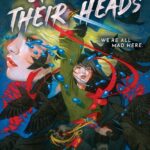
Genres: Queer Protagonists, Sci Fi, Magical Realism
Representation: Gay MC, M/M
Published on: 10th May 2022
ISBN: B09PHWV5J7
Goodreads

Dark Factory is a state-of-the-art club where reality is customizable: just scroll down the menu, and change your world. Ari Regon is the club’s floor manager, a wild card who makes things happen, Max Caspar is a stubborn and talented DIY artist. And they’re both chasing the same thing: the ultimate experience, a vision of true reality.
I received this book for free from the publisher. This does not affect my opinion of the book or the content of my review.
Highlights
~clubbing with virtual reality
~music that brings the house down
~what is reality anyway?
~and can we change the answer?
If you know Koja already, then she needs no introduction; if this is the first book of hers you’ve considered, then no introduction can do her justice.
Dark Factory is the intertwined story of Ari and Max, two very different people with – at least initially – very different views on immersive experiences. Ari is the heart of the eponymous Dark Factory, a club that uses a Santa-sack of technology to create a kind of catered reality for its patrons, a wild fantasy party that never ends and can’t be found anywhere else. Max, on the other hand, is a strong believer of meat over virtual, creating living and immediate art installations in garages and groves for people to experience in person, without Y – Y being an advanced virtual reality technology that more and more games and clubs are making use of.
They’re diametrically opposed characters, and when they first meet it’s with barely-repressed hostility – but quite quickly they realise that their individual philosophies are both missing what the other person has to offer. Ari, in particular, recognises genius in Max and understands how much more they could accomplish together – and it doesn’t take as long as you’d think for Max to come to the same conclusion.
I have to admit, I didn’t understand everything Ari and Max said and thought about what they saw and wanted to do, but the heart of it was the creation of experiences that are real, as real as possible – to the point of reaching for, and even creating, a new kind of reality. Woven through the narrative is the quiet but powerful assertion that people like Max – and Felix, an incredible DJ who hears a hum beneath the sounds of the world – are seeing something the rest of us can’t; are seeing, perhaps, objective reality rather than the subjective one the rest of us exist in. The quest, then, if it can be called that, is Ari, Max’s, and Felix’s determination to learn how to show other people that objective reality – or even bring them into it with them.
the security lights blooming like orange moons in a rain so fine it is barely mist, like moving through someone’s exhaled breath.
Dark Factory has been described elsewhere as near-future SF, and there’s also some is-it-isn’t-it supernatural undercurrents, but mostly I’d recommend this for readers who are happy to read books where the fantastical elements are more subtle. Dark Factory strikes me as a cross between sci-fi and magical realism, with the dial turned down on the spec-fic and turned up on the characters, their relationships and dynamics with each other. And it really, really works.
But it’s Koja’s unique, signature writing style that makes Dark Factory as unputdownable as all her previous books. Koja’s prose is fundamentally unique, not so much in the way she uses language (although she has a peerless grasp of language as well) as in the way she uses structure, particularly sentence structure; run-on sentences snap into dialogue and out again, quick and gleaming and sweeping the reader away. It’s wonderfully appropriate that Koja has written a book about immersive reality when her own prose is some of the most immersive I’ve ever read; it gives Dark Factory a weight it wouldn’t have otherwise, makes the reader feel what Ari and Max are talking about even if we don’t completely understand. It becomes something we know, something we get, even if we can’t put it into words; visceral and mesmeric and wickedly enchanting.
Ari watches that quiet face, feeling his own heart alive and glowing like a saint’s in a church window
And of course, we have to talk about the experimental structure of this novel; the inclusion of ‘extras’ such as news articles and interviews with the main characters, the companion website for Dark Factory the club, music and social media woven in and out of the pages to make Dark Factory something as unique as the experience Ari and Max are trying to create. I never thought it was going to be gimmicky, and it isn’t in the slightest; what it does is blur the lines between fiction and reality even more than a good book usually does, leaving you with brief flashes of uncertainty as to whether Ari and the rest are really real or only fictional – and is there a difference, really, when experiencing fiction affects you as much as a ‘real’ experience would? If our realities are all subjective, and I experience Ari and Max and Felix and what they go through, then doesn’t that make them real in my own subjective reality?
I can almost hear Koja whispering Yes.
Dark Factory enters our reality on May 10th. Don’t miss it!





[…] Full Review: Clubbing in the Future: Dark Factory by Kathe Koja — Every Book a Doorway […]